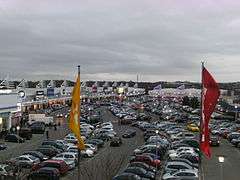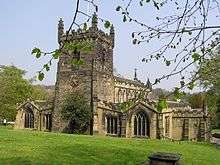Birstall, West Yorkshire
Birstall is a large village in the metropolitan borough of Kirklees, West Yorkshire, England.[1][2] It is part of Birstall and Birkenshaw ward which had a population of 16,298 at the 2011 census.[3] Historically in the West Riding of Yorkshire, it is situated close to the M62 motorway, approximately 6 miles (10 km) south-west of Leeds. The village is situated between Leeds, Bradford, Huddersfield and Wakefield.
| Birstall | |
|---|---|
Statue of Joseph Priestley in Birstall Market Place | |
 Birstall Location within West Yorkshire | |
| Population | 16,298 (Birstall & Birkenshaw Ward. 2011) |
| OS grid reference | SE241242 |
| Metropolitan borough | |
| Metropolitan county | |
| Region | |
| Country | England |
| Sovereign state | United Kingdom |
| Post town | BATLEY |
| Postcode district | WF17 |
| Dialling code | 01924 |
| Police | West Yorkshire |
| Fire | West Yorkshire |
| Ambulance | Yorkshire |
| UK Parliament | |
History
Birstall's name is derived from the Old English byrh and stall meaning a fortified site.[4]
Birstall is not mentioned in the Domesday Book but is alluded to as one of two settlements in Gomersal. Pigot's National Commercial Directory for 1828-29 listed it as one of the four villages which make up the township of Gomersal.
The hill fort itself would have been situated high above the village, to one side of the present-day Raikes Lane, which heads towards Gildersome, and onto Leeds. In prehistoric days, trackways ran in various directions from one British settlement to another, one such settlement being on the top of Birstall Hill. This site was chosen for its central location amongst the nearby waterways and its accessibility to and from other nearby hill forts, such as Castle Hill at Almondbury in Huddersfield and Barwick-in-Elmet, near Leeds. Following the course of Fieldhead Lane towards Drighlington is the Roman road of Tong Street. This location would give Birstall a great geographical advantage, making it within easy reach of the main thoroughfares of ancient Yorkshire.
A Roman tiled mosaic was unearthed at Birstall Smithies, a former early industrial slag smelting site, during excavations in 1965. This and a hoard of Roman coins discovered at the foot of Carr Lane, on what was then Birstall Recreation Ground indicate quite succinctly as to the prehistoric origins of Birstall. These coins, which were discovered in the 18th century, dated from 192 to 268 AD.
A quarter of a mile up the hill from Birstall on Leeds Road, there was once a Roman watch tower. This observation point was built on the ridge or "brae" of the hill. One side overlooked the Birstall area, while the other looked downwards from Howden Clough and the valley towards upland Morley. This watchtower was known in the early 20th century to the local inhabitants as the Brass Castle, a corruption of Brae Castle. It followed the line of other such structures built in West Yorkshire, atop prominent projecting ridges.
Moat Hill, just off Leeds Road, was once the site of an important meeting place. An Anglo-Saxon parliament would meet here several times a year to discuss laws and "mete" out punishment. For the word moat (meet?) is a corruption of an ancient word, pronounced "mute", meaning a meeting place for official decisions. There were only a handful of these places in Anglo-Saxon Britain, with Birstall having been host to one of them. Others were in Scotland and at Tynwald Hill, on the Isle of Man, which still meets annually to this day, and forms the historic place of parliament for that independent island.
Birstall is the birthplace of Joseph Priestley, the discoverer of oxygen. Priestley was tutored extensively by the then Vicar of Birstall, an Edinburgh man with a keen interest in science. He was also a pupil at Batley Grammar School for Boys, founded in 1612 by the Rev. William Lee. The school still remains on Carlinghow Hill, approximately one mile from Birstall.
Also born here was John Nelson, a stonemason who was converted by John Wesley to Methodism whilst working in London and who returned to Birstall and became one of Wesley's most important preachers.
Birstall was prosperous before the Industrial Revolution, being within a small area that was a centre for the English white cloth industry. However, the Industrial Revolution saw extensive growth, and the architecture of the period still dominates today. The wider area became known as the Heavy Woollen District, although the decline in textile production has led to a decline in its usage; it is still used in local sport, however. Of this period is the cobbled marketplace with a statue of Priestley, which was erected in 1912 by public subscription and sculpted by Frances Darlington. It is one of the very few pieces of her work on public display.
Before 1937, Birstall had its own urban district council before a merger with the UDC of neighbouring Batley. Just over 30 years later, this, in turn, was merged into Kirklees when the metropolitan councils were formed.
On 16 June 2016, the local member of parliament Jo Cox was shot and stabbed in Birstall outside the library where she was due to hold a surgery for local constituents. She later died of her injuries.[5]
Community


Birstall has grown substantially because of the expansion of Leeds, becoming a commuter village of a more rural nature.
The village has retail areas adjacent to Junction 27 of the M62, Birstall Shopping Park, also referred to as West Yorkshire Retail Park, which includes a DW Sports shop and fitness club, IKEA, Next stores and a Showcase Cinemas complex. In addition to Birstall Shopping Park, there is the Junction 27 Retail Park, which specialises in bulky goods and electronics and is under different ownership to Birstall Shopping Park.
Birstall contains a triangular-shaped Victorian marketplace, which replaced an earlier market on High Street in the Georgian area of the village. Market day is Thursday.
Birstall's community groups and traders organise the "Birstall in Bloom" project, which started in 2010. The local 'Chamber of Trade' promotes local businesses. Shops and outlets include a florist, baker's, butcher's, travel agent, pet shop, hair dresser's, nail bar, fish shop, Cafes and hot sandwich shops.
The Chamber of Trade organise the annual Christmas lights with a big switch on event on the last Tuesday in November.
Village centre improvements
In mid-2008 the local council's area committee invested £900,000 in refurbishing the Birstall marketplace and regenerating the village after a campaign by locals. The refurbishments were completed in December 2008 with most of the original cobbles being taken away and replaced with a level stone surface with randomly cobbled stripes. New lighting has been erected throughout the village centre along with a CCTV system.
Landmarks

Birstall's St Peter's Church dates to the time of Henry VIII, although the original tower is much earlier and may have been part of the original "Burgh Stall" or "Fortified Place". A family reconstitution of the parish registers of St Peter's, Birstall (1595–1812) was undertaken by Harvey Thwaite, and is one of the group of twenty-six family reconstitution studies that have been extensively used by the Cambridge Group for the History of Population and Social Structure.
Close to Birstall is Oakwell Hall, an Elizabethan manor house romanticised by Charlotte Brontë as 'Fieldhead' in her novel Shirley.
An 18th-century windmill stands in the grounds of Windmill Church of England Primary School (formerly St Saviour's Junior School) and has provided local names such as 'Windmill Estate' and 'Miller's Croft'.
The Black Bull Inn is situated behind St Peter's Church on Kirkgate. Its upstairs room was once used as a magistrate's court for Birstall and Gomersal, and is now Grade 2 listed.[6]
A statue of Joseph Priestley, who was originally from Birstall, is situated in The Village Market Square.
Location grid
References
- Ordnance Survey: Landranger map sheet 104 Leeds & Bradford (Harrogate & Ilkley) (Map). Ordnance Survey. 2014. ISBN 9780319231654.
- "Ordnance Survey: 1:50,000 Scale Gazetteer" (csv (download)). www.ordnancesurvey.co.uk. Ordnance Survey. 1 January 2016. Retrieved 30 January 2016.
- "Kirkless ward population 2011". Neighbourhood Statistics. Office for National Statistics. Archived from the original on 14 March 2016. Retrieved 24 February 2016.
- The Cambridge Dictionary of English Place-Names, edited by Victor Watts Cambridge University Press 2004.
- "Jo Cox MP dead after shooting attack". BBC. Retrieved 16 June 2016.
- Burnett, Alan. "34 : The Black Bull Inn, Birstall".
External links
| Wikimedia Commons has media related to Birstall, West Yorkshire. |